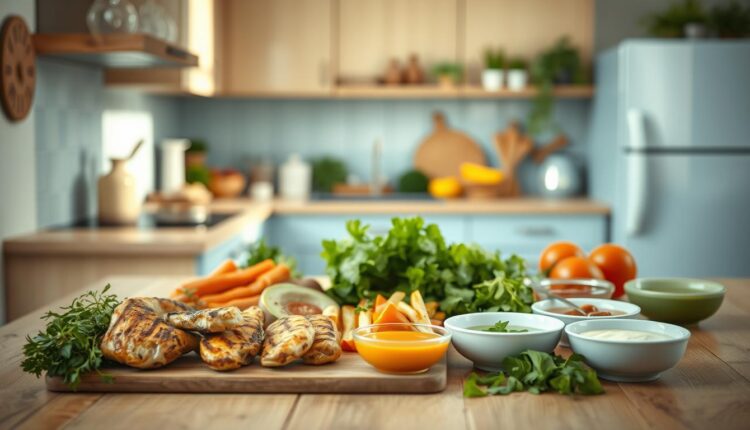Meal Prep For Work Flavor Variety Without Boredom
Discover meal prep for work flavor variety with our expert tips and recipes. Say goodbye to boring lunches and hello to delicious, stress-free meal prep.
Raise your hand if you’ve ever stared at another sad desk salad and thought, “There has to be a better way.” I’ve been there too—until I discovered how strategic planning could turn my midday fuel into something I genuinely look forward to.
This isn’t about rigid routines or eating the same chicken-and-broccoli combo five days straight. It’s about building flexible frameworks that let you mix textures, cuisines, and ingredients without last-minute scrambling. Think vibrant grain bowls on Monday, zesty wraps by Wednesday, and globally inspired soups come Friday—all prepped in one focused session.
Through trial and error (and a few freezer disasters), I’ve learned that successful planning balances three elements: smart batch cooking, strategic ingredient swaps, and what I call “flavor anchors”—sauces or spices that transform basics into craveable creations. We’ll explore how to:
- Design weekly menus that feel fresh yet require minimal effort
- Repurpose core ingredients across multiple dishes
- Store foods properly to maintain texture and taste
At Prepistry, we believe organized cooking should adapt to your schedule, cravings, and pantry—not the other way around. Let’s create lunch breaks worth savoring.
Embracing Meal Prep for Work Flavor Variety
Ever opened your lunchbox with genuine anticipation? That’s the magic of reimagining midday meals. What used to feel like a chore becomes a highlight when you treat planning as a creative playground—not a rigid checklist. Busy schedules thrive on systems, and modern strategies prove organized cooking can be anything but monotonous.
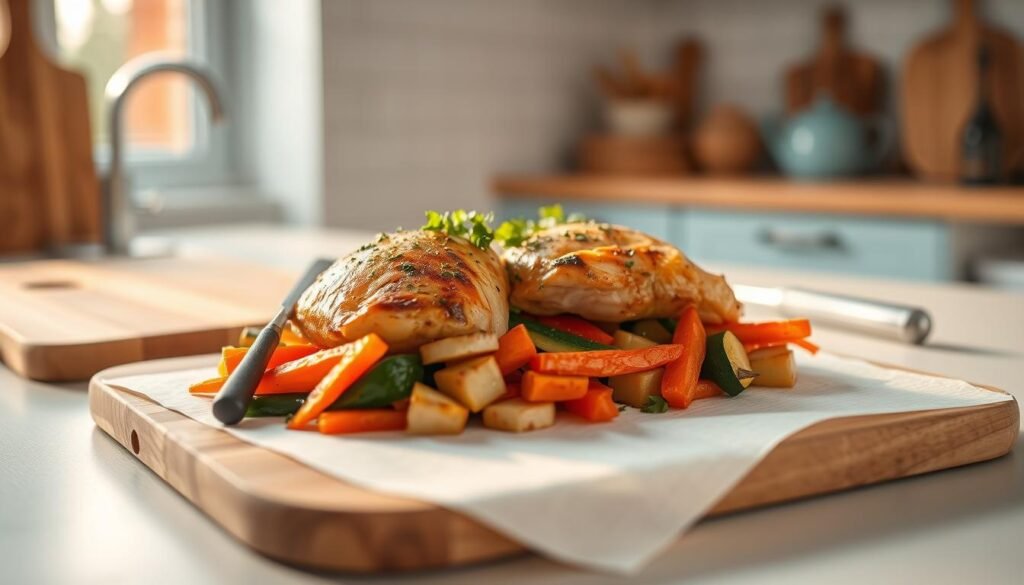
Vibrant veggies and savory proteins like chicken become building blocks for endless combinations. Roasted peppers add sweetness to grain bowls Monday, then pair with lime-marinated chicken in tacos by Thursday. This approach aligns with research showing structured routines reduce decision fatigue while boosting nutritional variety.
Here’s the secret: simplicity fuels creativity. A well-stocked spice drawer and three core recipes can yield a week’s worth of distinct dishes. Think:
- Zesty lemon-herb chicken doubling as salad toppers or wrap fillings
- Rainbow roasted vegetables starring in nourish bowls or blended soups
- Batch-cooked grains transforming into breakfast porridge or fried “rice”
Your lunch break should spark joy, not sighs. With smart prep-ahead techniques, even time-crunched weekdays can deliver fresh, craveable flavors.
Why Creative Meal Prep is Essential for Busy Workweeks
Ever hit that midweek energy slump where even coffee can’t save you? I’ve learned the hard way: what you eat at your desk directly impacts your afternoon focus. Strategic kitchen prep isn’t just about saving time—it’s about crafting meals that excite your taste buds and fuel your productivity.
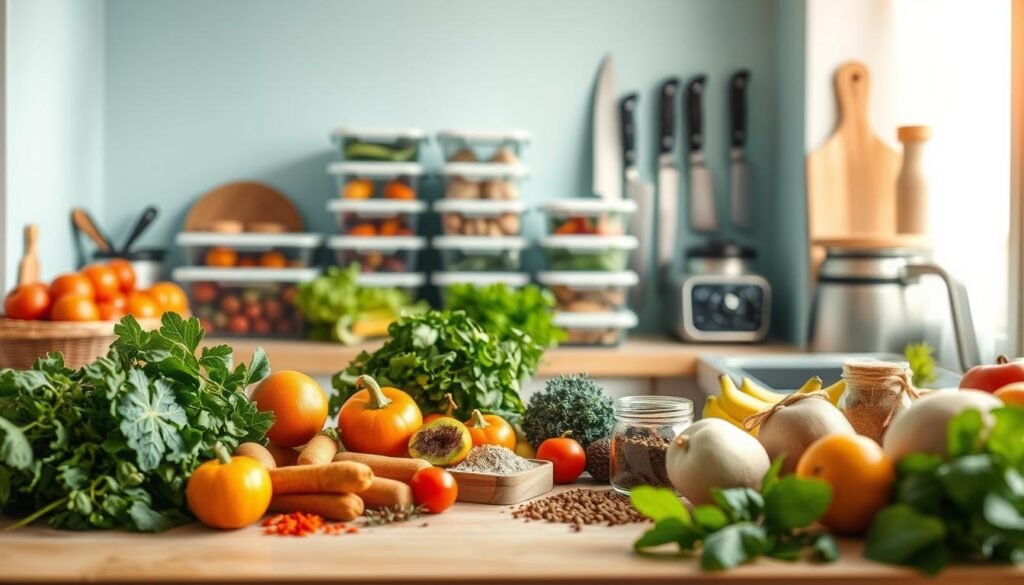
Benefits of Flavor Variety
Let’s talk rice bowls—the ultimate blank canvas. One batch of jasmine rice becomes:
- Breakfast fried “rice” with scrambled eggs and sesame oil
- Lunchtime burrito bases with lime-cilantro dressing
- Dinner stir-fry platforms starring ginger-glazed veggies
This approach prevents taste fatigue while maximizing ingredients. I recently discovered global breakfast ideas that transformed my mornings—think coconut chia pudding or shakshuka-inspired egg muffins.
Staying Energized Throughout the Day
The right combinations keep energy steady. Pair complex carbs like brown rice with proteins and fats: kimchi adds probiotics to grain bowls, while avocado boosts satiety in wraps. My go-to formula?
- 40% colorful veggies (roasted peppers, massaged kale)
- 30% lean protein (turkey meatballs, marinated tofu)
- 30% hearty base (quinoa, sweet potato noodles)
These ratios deliver sustained energy without afternoon crashes. Remember: when food tastes vibrant, you’re more likely to stick with routines that actually work.
Incorporating Fresh and Vibrant Ingredients
How often do you find wilted spinach hiding in your fridge by Thursday? Seasonal picks and sturdy vegetables solve this problem while keeping lunches lively. Think beyond basic salads—roasted root vegetables or charred summer squash add depth to dishes while stretching your grocery budget.
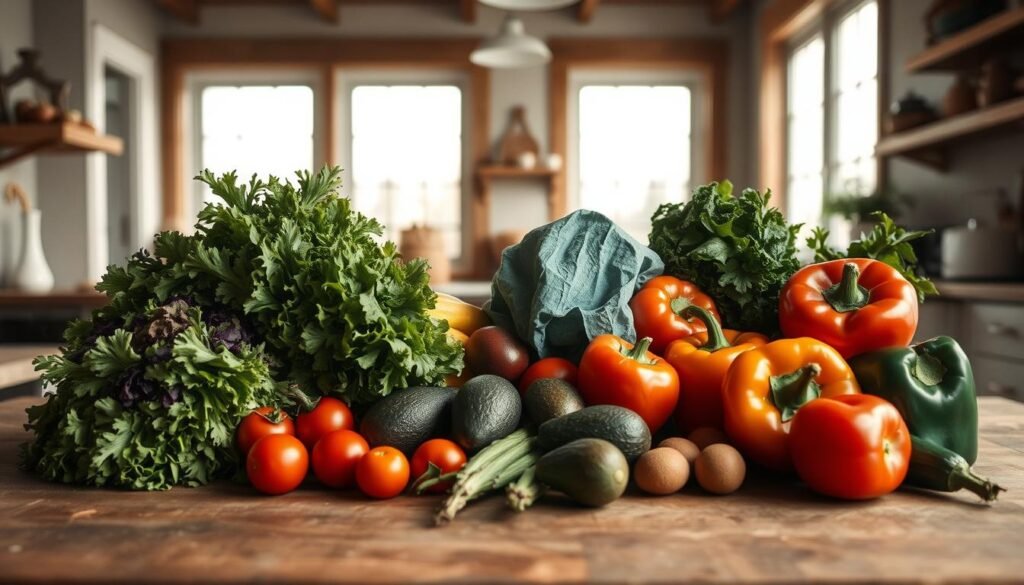
Using Seasonal Produce and Hearty Veggies
Farmers’ markets aren’t just weekend adventures—they’re goldmines for flavor-packed ingredients. I once swapped bland January tomatoes for roasted Brussels sprouts in grain bowls. The result? A smoky-sweet crunch that made coworkers ask for the recipe.
Here’s why this works:
- Peak freshness means better taste and nutrients—think juicy berries in June or crisp apples come October
- Sturdy greens like kale hold up better in containers than delicate lettuce
- Roasted chickpeas add protein and texture to meals without soggy disasters
| Vegetable | Season | Meal Prep Use |
|---|---|---|
| Zucchini | Summer | Spiralized noodles, grilled skewers |
| Butternut Squash | Fall | Soup bases, roasted cubes |
| Kale | Winter | Massaged salads, baked chips |
Time your grocery runs for Wednesday mornings when stores restock. This ensures the freshest greens and chickpeas for Thursday prep sessions. Pro tip: Blanch broccoli florets before storing—they’ll stay bright green all week.
Your meals deserve ingredients that spark joy. Start with one seasonal swap this week, like tossing roasted beets into grain bowls or blending pumpkin into soups. Small changes create big flavor wins.
Ensure freshness by using seasonal produce—properly store to avoid waste and keep meals flavorful all week.
Exploring Creative Meal Prep Recipes
What if your morning routine could taste like weekend brunch? I discovered the joy of stress-free mornings through two game-changers: jarred breakfasts and muffin-tin miracles. These solutions prove that quick assembly doesn’t mean sacrificing excitement at your desk.

Morning Magic in Jars and Muffin Tins
My current obsession? Overnight oats with unexpected twists. Combine rolled oats, almond milk, chia seeds, and a dash of cinnamon—then let your fridge work overnight. Come sunrise, top with toasted coconut or fresh berries for crunch. Need savory options? Whisk eggs with diced peppers and spinach, bake in muffin tins for 18 minutes, then freeze. Reheat three mornings straight without losing moisture.
Lunchtime Canvas: Build-Your-Own Bases
Salads and bowls shine when you layer textures smartly. Start with quinoa or farro as your foundation—these grains hold up better than greens alone. Add roasted sweet potatoes on Monday, then swap in grilled zucchini by Wednesday. Keep dressings separate until serving to maintain crispness.
Here’s my secret for no-soggy success:
- Store components in stackable containers
- Add nuts or seeds just before eating
- Use citrus-based vinaigrettes to brighten leftovers
One reader shared how this system transformed her lunches: “I finally look forward to opening my lunchbox—it’s like a flavor adventure every day!” With 10 minutes of nightly assembly, you’ll ditch the desk salad slump for good.
Mediterranean-Inspired Meal Prep Ideas
Have you ever tasted sunshine in a bowl? That’s the magic of Mediterranean cooking—bright flavors that transport you to coastal villages with every bite. Last summer, a friend shared her Greek aunt’s chickpea salad recipe, and it revolutionized my approach to midday meals.

Chickpea Salad & Quinoa Bowls: A Protein Powerhouse
Garlic, lemon, and fresh herbs like oregano or mint create bold profiles without heavy sauces. Combine chickpeas (packing 15g of protein per cup) with quinoa for a complete amino acid profile. Add diced cucumbers, cherry tomatoes, and Kalamata olives for crunch and briny depth.
| Ingredient | Role | Prep Tip |
|---|---|---|
| Chickpeas | Protein base | Roast with cumin for smokiness |
| Quinoa | Nutty texture | Cook in vegetable broth |
| Feta Cheese | Salty tang | Add just before serving |
Mediterranean spices like sumac or smoked paprika elevate ordinary grains. A reader once told me, “Adding roasted garlic to my quinoa made it taste like a restaurant side!” Balance is key: pair protein-rich bases with vibrant veggies like roasted red peppers or artichoke hearts.
These dishes adapt effortlessly. Swap feta for grilled chicken, or toss in preserved lemons for extra zing. Explore authentic Mediterranean lunch ideas to keep your routine fresh. As my Greek friend says, “Good food needs three things: quality ingredients, bold seasoning, and a little love.”
Tips to Maximize Flavor Without Extra Effort
Ever packed lunch only to find it bland by Wednesday? I once faced this struggle until discovering how a few pantry staples could revive leftovers. The secret lies in layering bold accents that build over time—no extra chopping required.
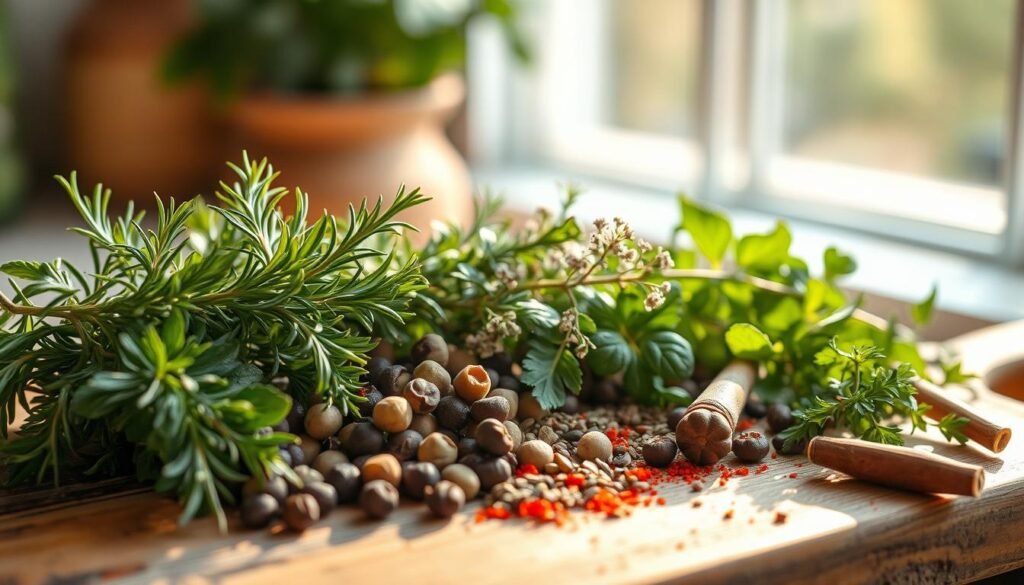
Smart Use of Herbs, Spices, and Marinades
Transform basic ingredients with these kitchen-tested tricks:
- Lemon multitasking: Zest citrus before juicing—add bright notes to grains or roasted chickpeas
- Onion alchemy: Thinly slice red onions for quick-pickling (1:1 vinegar-water + pinch of sugar)
- Spice blends: Mix smoked paprika, garlic powder, and oregano for smoky depth in 30 seconds
Marinades work while you sleep. Try this no-fuss option: whisk olive oil, lemon juice, minced garlic, and rosemary. Pour over chicken or tofu overnight. By morning, proteins absorb tangy richness without hands-on effort.
| Ingredient | Flavor Boost | Time Saver |
|---|---|---|
| Chickpeas | Roast with cumin + chili | Ready in 20 mins |
| Caramelized Onions | Sweetens soups & bowls | Make 1 batch weekly |
| Lemon Zest | Brightens dressings | Use microplane |
One reader shared: “Adding za’atar to hummus made my wraps taste like a Mediterranean cafe!” Remember—small tweaks create big impact. Keep pre-mixed spice jars and citrus handy for instant upgrades.
Meal Prep for Work Flavor Variety: Tactics to Beat Boredom
The secret to lunchtime excitement lies in your refrigerator’s compartments. I once prepped six components on Sunday that became 12 distinct lunches—all because I stopped planning full dishes and started stockpiling building blocks. This “choose-your-own-adventure” approach keeps midday eating fresh without extra effort.

Mix-and-Match Components for Diverse Meals
Think of your kitchen like a well-organized deli case. Roast two sheet pans of vegetables, batch-cook a grain and protein, then keep sauces and crunchy toppings on hand. At home, assemble combos that suit your mood:
- Bases: Quinoa, roasted potatoes, or spinach
- Proteins: Lemon-herb chicken, spicy chickpeas, or hard-boiled eggs
- Toppings: Pickled onions, toasted almonds, or crumbled feta
Starchy elements like potatoes add staying power. Pair them with bright veggies and lean proteins for balance. One reader shared: “Roasted sweet potatoes saved my lunches—they work in tacos, salads, or even breakfast hash!”
A healthy meal prep routine thrives on flexibility. Keep components separate until serving to maintain textures. Need inspiration? Try these combos:
| Base | Protein | Veggie |
|---|---|---|
| Farro | Turmeric tofu | Charred broccoli |
| Massaged kale | Shredded turkey | Roasted peppers |
With this system, you control portions and flavors daily. It’s budget-friendly too—leftover grains become tomorrow’s stir-fry, and extra veggies blend into soups. Your hands-on time stays minimal, but your taste buds never get bored.
Techniques for Long-Lasting, Tasty Meals
Imagine your Friday lunch tasting as fresh as Monday’s—here’s how. The difference between vibrant and soggy lies in smart storage and reheating tricks I’ve perfected through years of trial (and occasional kitchen disasters).
Start with airtight glass containers. They prevent moisture buildup that turns crisp veggies limp. Layer ingredients strategically: dressings at the bottom, greens on top. For Mediterranean chickpea salad, keep feta separate until serving to maintain its crumbly texture.
Reheating matters more than you think. Microwave grains with a damp paper towel to revive fluffiness. Crispy elements like roasted chickpeas? Use a toaster oven instead of microwaving. One reader shared: “Sautéing Thursday’s quinoa in a pan made it taste freshly cooked!”
| Method | Benefit | Example Recipe |
|---|---|---|
| Freezer Portions | Locks in freshness | Lentil soups |
| Parchment Dividers | Prevents sogginess | Grain bowls |
| Vacuum Sealing | Extends shelf life | Marinated proteins |
Batch cooking shines when you choose fridge-friendly dishes. That Mediterranean chickpea salad? Its lemon-olive oil base acts as a natural preservative. Prep recipes with sturdy ingredients—roasted roots hold up better than delicate greens.
Your healthy meal deserves to stay delicious all week. With these techniques, Thursday’s lunch will taste as vibrant as Sunday’s prep session. No more sad desk salads—just fresh, satisfying bites that fuel your best work.
Freezer meals should be stored properly—use airtight containers to prevent freezer burn and preserve taste.
Budget-Friendly Meal Prep Ideas for the American Worker
How many times have you thrown away wilted veggies because your plans changed? I once wasted half a cabbage before realizing smart planning could stretch my grocery budget further. Budget Bytes taught me this golden rule: “Spend on staples, save on accents.” Let’s transform your kitchen into a money-saving powerhouse.
Smart Shopping and Bulk Cooking Strategies
Start with dry beans and grains—they cost pennies per serving. A 5-pound bag of chickpeas becomes 15+ meals. Pair with seasonal veggies like carrots or cabbage that stay crisp for days fridge storage. Downshiftology’s chickpea salad proves humble ingredients shine with bold seasoning.
Here’s how to maximize every dollar:
- Buy family packs of chicken thighs—roast half now, freeze the rest
- Slice red onion thinly—use raw in salads, pickle the rest for wraps
- Cook double batches of brown rice—freeze portions for stir-fries
One teacher shared her win: “I turned $20 into lunches for the entire week—chickpea salads, veggie wraps, and lentil soups!” Her secret? Repurposing leftovers. Thursday’s roasted veggies became Friday’s frittata filling.
| Ingredient | Cost Per Serving | Uses |
|---|---|---|
| Dry Lentils | $0.35 | Salads, soups, taco filling |
| Cabbage | $0.20 | Slaws, stir-fries, soup topper |
| Red Onion | $0.15 | Pickled garnish, salad base |
Remember: flavor thrives in simplicity. A squeeze of lemon or dash of smoked paprika elevates budget ingredients. Your wallet—and taste buds—will thank you.
Smart meal prep maximizes your grocery budget, turning humble ingredients into vibrant meals—without sacrificing flavor.
Essential Tools and Containers for Successful Meal Prep
Ever pulled a soggy wrap from your lunch bag? I learned the hard way: great ingredients need the right armor. Through years of kitchen experiments, I’ve discovered which tools keep creations crisp and vibrant—even on Friday.
Choosing the Right Storage and Prep Equipment
Mason jars aren’t just trendy—they’re functional powerhouses. Their tall shape keeps overnight oats layers intact: chia seeds at the bottom, fruits on top. One reader shared, “My peanut butter-banana oats taste freshly made four days later!”
For savory items like spring rolls or egg muffins, glass containers with compartments prevent flavor mingling. Look for leak-proof lids—they’re lifesavers for saucy dishes. Pro tip: Use silicone cupcake liners inside containers to separate dressings or dips.
| Container Type | Best For | Why It Works |
|---|---|---|
| Mason Jars | Overnight oats, layered salads | Prevents sogginess, stackable |
| Glass Containers | Spring rolls, egg muffins | Microwave-safe, easy to clean |
| Silicone Bags | Marinated proteins, chopped veggies | Reusable, freezer-friendly |
Organize your well fridge like a pro. Keep dressings and snacks at eye level, proteins on lower shelves. This “first seen, first eaten” approach cuts waste. A nurse told me, “Clear bins for chopped veggies changed my game—I actually use them now!”
Durable tools pay off. Invest in a quality vegetable chopper for uniform cuts that cook evenly. Stainless steel steamers keep grains fluffy, while silicone mats make roasting chickpeas foolproof. With these allies, your kitchen becomes a efficiency hub where tasty creations thrive all week.
Adaptable Recipes for Freezer-Friendly Meal Prep
What if Thursday’s lunch tasted as vibrant as Monday’s? Freezer-friendly dishes solve the midweek slump by locking in freshness until you’re ready to eat. During a chaotic holiday season, I discovered roasted vegetable lasagna freezes beautifully—and reheats like it’s straight from the oven.
Smart freezing starts with recipes built to withstand temperature changes. Mediterranean chickpea salad shines here: its lemon-olive oil dressing prevents ice crystals, while sturdy ingredients like roasted peppers retain crunch. One reader shared, “I thawed mine for a beach picnic—it tasted like I’d made it that morning!”
Avoid freezing watery veggies—they lose texture and can make meals unappetizing after thawing.
Quick Reheat and Retain Freshness During the Week
Not all dishes freeze equally. Soups and casseroles thrive, while watery veggies turn mushy. My golden rule? Freeze components separately. Cooked grains stay fluffy when stored alone, then combined with thawed proteins before serving.
| Recipe | Key Ingredient | Reheating Tip |
|---|---|---|
| Spinach-Feta Stuffed Shells | Ricotta | Cover with foil at 375°F |
| Moroccan Lentil Stew | Chickpeas | Stir in fresh herbs post-thaw |
| Greek Orzo Bake | Kalamata olives | Add feta after heating |
Portion control matters. Use silicone muffin tins for single-serving lasagna or chili. Glass jars with wide mouths work for soups—leave 1-inch space for expansion. Avoid plastic containers; they absorb odors over time.
These strategies let you cook once and eat well all month. As I learned after a zucchini noodle disaster: freezer meals reward planning, not guesswork. With the right recipes, even time-crunched weeks deliver restaurant-worthy lunches.
Conclusion
What if every lunch break felt like a mini culinary adventure, even on hectic workdays? Through smart ingredient combinations and storage hacks, you’ve seen how organized cooking transforms rushed afternoons into moments worth savoring. Those mason jars of roasted chickpeas? They’ll stay crunchy for days. That batch of lemon-herb quinoa? It becomes tomorrow’s breakfast bowl with a sprinkle of seeds.
True magic lies in simplicity. A well-stocked spice drawer and three core items—like roasted veggies, grains, and proteins—unlock endless possibilities. I once turned leftover turmeric rice into Friday’s fried “rice” by adding frozen peas and a fried egg. Small creative seeds grow into routines that feel anything but routine.
Your journey starts wherever you are. Swap one sad sandwich this week for a vibrant wrap using Tuesday’s grilled chicken. Share your wins with our community—we’re all learning together.
With thoughtful planning, your fridge becomes a treasure chest of ready-to-enjoy goodness. Here’s to lunches that fuel both body and spirit—one delicious day at a time.
Sesame Veggie Dumplings
These Sesame Veggie Dumplings are a nutritious and convenient snack, perfect for busy individuals seeking a high-protein, high-fiber option. Made with a variety of vegetables and protein-rich ingredients, they are ideal for meal prep and can be enjoyed throughout the week.
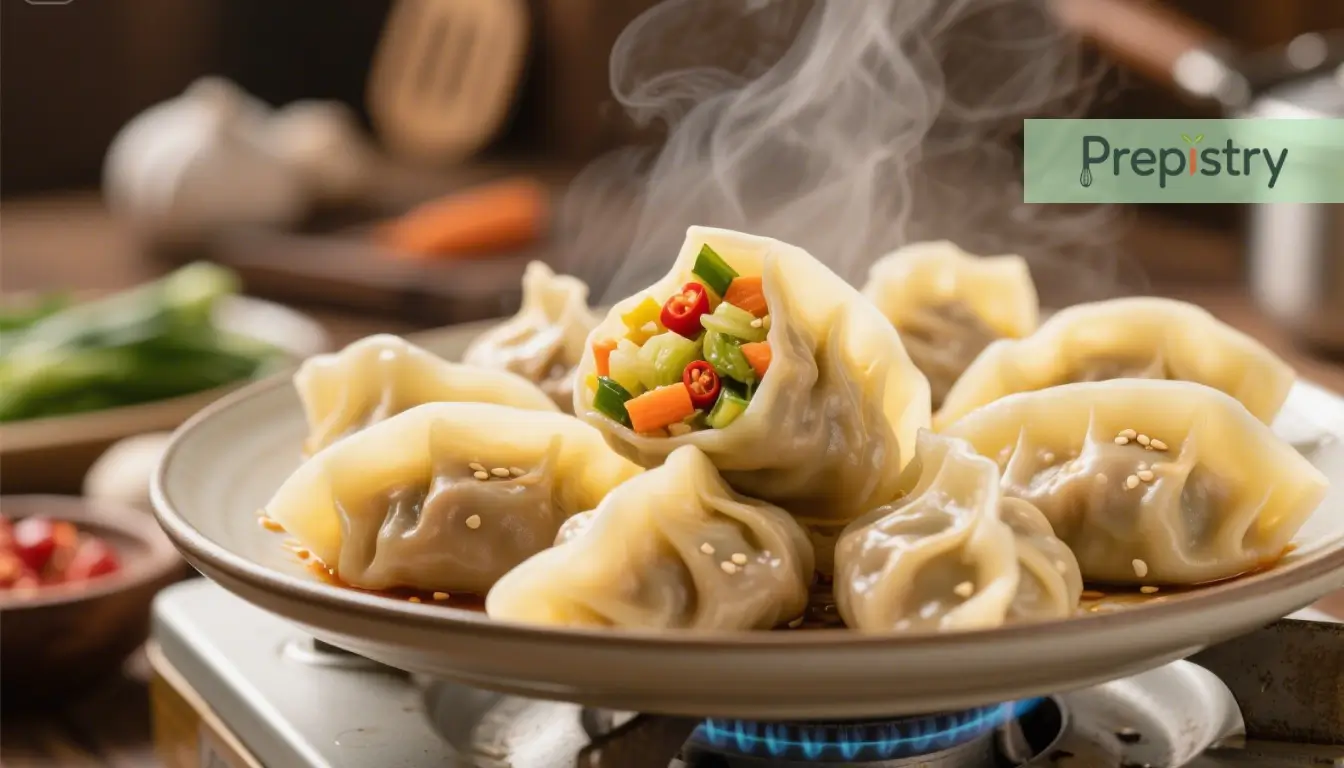
Nutrition Information
Equipment Needed
- Large mixing bowl
- Non-stick skillet or air fryer
- Sharp knife
- Cutting board
- Measuring spoons
Ingredients
-
1 cup shredded cabbage
-
1/2 cup sliced mushrooms
-
1/2 cup firm tofu, crumbled
-
2 tablespoons soy sauce
-
1 tablespoon sesame oil
-
1/2 teaspoon minced garlic
-
1/2 teaspoon grated ginger
-
12 rice paper wrappers
-
1 tablespoon sesame seeds
Instructions
Recipe Video
VEGAN DUMPLINGS with Sesame Seed Twist - MOMOS Recipe
We are preparing these Vegan Dumplings with a twist of sesame seeds. Check out this recipe to learn making the Vegan Dumplings from scratch. These steamed Vegan Dumplings are filled with a hearty mushroom filling. I have also prepared the Vegan Dumplings wrapper from scratch in this recipe as it was requested by many of you. Momo is a type of dumplings originally from Tibet which is prominently found in the cuisines of Tibet and Nepal, as well as in the Indian states of Ladakh and Sikkim. It has evolved and spread to many countries who have adapted it and modified it as per their preference. Dumplings are a crowd favorite and these Vegan dumplings are really easy to prepare at home. Vegan Dumpling Filling can be changed or modified as per your liking or taste buds.

